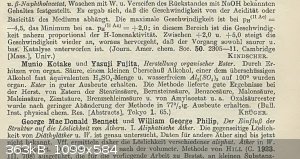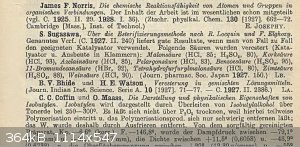| Pages:
1
2 |
tiger1
Harmless

Posts: 8
Registered: 13-4-2008
Location: Left Coast
Member Is Offline
Mood: Mojo Rising
|
|
Thanks Nicodem, good point on unstable intermediate.
|
|
|
DJF90
International Hazard
    
Posts: 2266
Registered: 15-12-2007
Location: At the bench
Member Is Offline
Mood: No Mood
|
|
If you have access to a dean stark trap, there is a paper utilising Fe2(SO4)3.xH2O as a catalyst for esterification, in toluene and alcohol leading to
almost quantitative yields in most cases. Two papers on the same subject, one for aromatic acids, the other for aliphatic.
|
|
|
Boffis
International Hazard
    
Posts: 1901
Registered: 1-5-2011
Member Is Offline
Mood: No Mood
|
|
@DJF90 do you have references for these two papers? They sound interesting on a general prep. level for esters
|
|
|
DJF90
International Hazard
    
Posts: 2266
Registered: 15-12-2007
Location: At the bench
Member Is Offline
Mood: No Mood
|
|
Yes I do, but I'm on a mobile device at the moment. I'll post them in the morning if I remember, otherwise send me a U2U to remind me.
EDIT: As promised...
[Edited on 26-10-2011 by DJF90]
Attachment: Fe2(SO4)3.xH2O catalysed esterification of aromatic acids.pdf (176kB)
This file has been downloaded 1513 times
Attachment: High yielding esterification.pdf (135kB)
This file has been downloaded 1225 times
|
|
|
DoctorZET
Harmless

Posts: 42
Registered: 25-1-2014
Location: In the lab
Member Is Offline
Mood: tasting a pure sample of madness
|
|
well, once you have the malonic acid (watch discussion board at ~LINK: http://www.sciencemadness.org/talk/viewthread.php?tid=1600&a... ~), you can try this much more simple way:
HOOC-CH2-COOH + 2 CH3-CH2-OH (with excess) --(traces of H2O, dehydrated CaCl2, HCl bubbles in solution, 70-80*C)--> Et-OOC-CH2-COO-Et ,
where the moisture is absorbed by CaCl2 while some gasos HCl dissolve in solution and protonates the alcohol to form the diethylmalonate ester.
now you have to heat the resulting compounds to 50*C for a while to allow remaining HCl and ethanol to escape from solution, then let the CaCl2 to
collect to the bottom and there you have it : pure diethylmalonate ester
If you use instead of HCl and CaCl2 , some H2SO4 ... you will have problems with separating the ester and with the conversion of ethanol to diethyl
ether during the reaction.
|
|
|
AvBaeyer
National Hazard
   
Posts: 655
Registered: 25-2-2014
Location: CA
Member Is Offline
Mood: No Mood
|
|
Having looked carefully at the experimental sections for both of the papers cited by DFJ90 above, I find it hard to believe that the ferric sulfate is
doing anything for the reported esterification reactions in the absence of data for control reactions without ferric sulfate. The esterifications are
being driven by the removal of water, not by any ferric sulfate catalysis.
AvB
|
|
|
Mush
National Hazard
   
Posts: 634
Registered: 27-12-2008
Member Is Offline
Mood: No Mood
|
|
Mechanism of ferric sulphate catalysed esterification
Bioresource Technology 101 (2010) 7338–7343
Ferric sulphate catalysed esterification of free fatty acids in waste cooking oil
Alternative prep. methods
aluminum(III) sulfate, sulfuric acid, T= 100 °C
Kotake; Fujita; Rikagaku Kenkyusho Iho; vol. 1; p. 65
sulfuric acid, toluene, calcium carbide, yield:95,6%
Thielepape; Chemische Berichte; vol. 66; (1933); p. 1460
silver malonate, ethyl iodide, Time= 3h, T= 95 °C
Journal of labelled compounds and radiopharmaceuticals; vol. 47;
11; (2004); p. 779 - 786
Attachment: thielepape 1933 ber 1460 malonic acid carbide toluene sulfuric acid abs etoh.pdf (438kB)
This file has been downloaded 439 times
Attachment: shin2004 ag malonate ethyl iodide.pdf (112kB)
This file has been downloaded 456 times
Attachment: gan2010 Ferric sulphate catalysed esterification of free fatty acids in waste cooking oil.pdf (318kB)
This file has been downloaded 399 times
|
|
|
Methyl.Magic
Hazard to Others
  
Posts: 139
Registered: 14-5-2007
Member Is Offline
Mood: No Mood
|
|
Personally I also doubt about the activity of Fe2(SO4)3 for esterficiation. Yes Fe +3 is a lewis acid but ... I don't know I does not 'feel' good.
The most important thing here is to remove water from the reaction to push the equilibrium to the ester buy removing continuously the water formed
along to "Lechatelier" Principle.
You can continuously remove water by azeotrope with i.e. toluene but for this reaction the problem is alcohol is also removed by azeotrope and has a
lower bp. This reaction use a catalytic amount of TsOH or better my favorite amberlyst-15 resin 
The best option is to stay with H2SO4. Cheap and easy to get. Sulfuric acid is EXTREMELY dehydrating : less than 0.5 eq is way more than enough. If
too much is added it can kills malonate by inter-dehydrating it. I bet you can also do the reaction without heating thanks to the dehydrating power of
sulfuric acid. After a long reaction time, add water, extract with toluene of suitable solvent, combine the phases, washed the malonate with NaOH
solution,dry over MgSO4 then distill the toluene and the malonate. Its just an idea 
|
|
|
Mush
National Hazard
   
Posts: 634
Registered: 27-12-2008
Member Is Offline
Mood: No Mood
|
|
aluminum(III) sulfate, sulfuric acid, T= 100 °C
Kotake; Fujita; Rikagaku Kenkyusho Iho; vol. 1; p. 65
Chemisches Zentralblatt; vol. 99; no. II; (1928); p. 1545

With hydrogen-chloride
Sugasawa; Yakugaku Zasshi/Journal of the Pharmaceutical Society of Japan; (1927); p. 150; Chemisches Zentralblatt; vol. 99; nb. I; (1928); p. 1643
With sulfuric acid
Sugasawa; Yakugaku Zasshi/Journal of the Pharmaceutical Society of Japan; (1927); p. 150; Chemisches Zentralblatt;
vol. 99; nb. I; (1928); p. 1643

With phosphoric acid
Lipp, Svetlana V.; Krasnykh, Eugenii L.; Verevkin, Sergey P.; Journal of Chemical and Engineering Data; vol. 56; nb. 4; (2011); p. 800 - 810
Attachment: lipp_2011_phosphoric acid diethyl malonate.pdf (973kB)
This file has been downloaded 372 times
Lipp, S. V.; Krasnykh, E. L.; Levanova, S. V. Retention indicesof symmetric dicarboxylic acid esters.J. Anal. Chem.2008,63, 349–352.
Attachment: Retention indices of symmetric dicarboxylic acid esters.pdf (166kB)
This file has been downloaded 416 times
[Edited on 15-8-2020 by Mush]
|
|
|
DraconicAcid
International Hazard
    
Posts: 4416
Registered: 1-2-2013
Location: The tiniest college campus ever....
Member Is Offline
Mood: Semi-victorious.
|
|
Quote: Originally posted by Methyl.Magic  | | After a long reaction time, add water, extract with toluene of suitable solvent, combine the phases, washed the malonate with NaOH solution,dry over
MgSO4 then distill the toluene and the malonate. |
I would expect sodium hydroxide to rapidly destroy the malonate ester, either by simple hydrolysis, or deprotonation of the central carbon.
Please remember: "Filtrate" is not a verb.
Write up your lab reports the way your instructor wants them, not the way your ex-instructor wants them.
|
|
|
Dr.Bob
International Hazard
    
Posts: 2819
Registered: 26-1-2011
Location: USA - NC
Member Is Offline
Mood: Mildly disgruntled scientist
|
|
Washing with sodium hydroxide solution (or perhaps better sodium bicarbonate or carbonate) should not destroy much of the ester as long as it is a
wash for a few minutes, and not a long mixing. After the base wash, wash with brine to remove any remaining base. The basic hydrolysis of an
ester is best done with a water miscible organic solvent (not toluene) that will allow the base and ester to contact each other for a long time. So
merely washing with base in water, when using a hydrophobic solvent like toluene will not destroy much ester. The hydrolysis and even the
deprotonation of diethyl malonate take a long time in the correct solvent mixture.
|
|
|
| Pages:
1
2 |